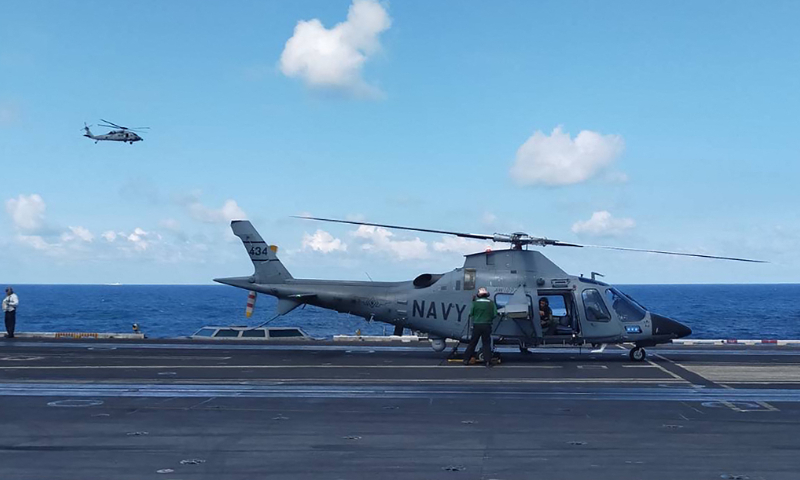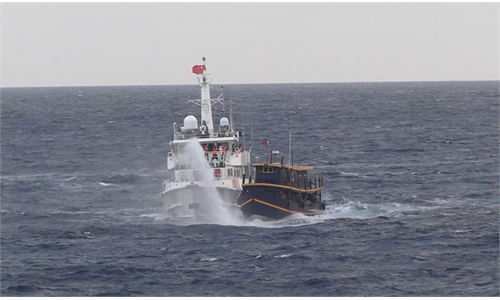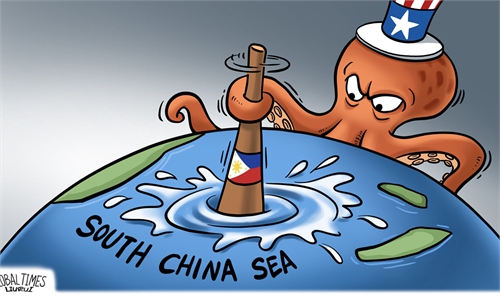Tit-for-tat confrontation in S.China Sea is caused by the US and Philippines: Global Times editorial

The photo taken on January 4, 2024 shows Filipino military personnel inspecting their aircraft on the US aircraft carrier USS Carl Vinson before takeoff. Photo: VCG
From January 3 to 4, a highly notable scene unfolded in the relevant waters of the South China Sea. Several military vessels from the US and the Philippines were engaged in what they termed the second joint patrol in the South China Sea. Simultaneously, not too far away, the Chinese People's Liberation Army Southern Theater Command organized navy and air forces for routine patrols. Many observers interpreted this as a tit-for-tat confrontation between the Chinese and the US military forces, objectively escalating tensions in the South China Sea. However, it must be noted that it is the actions of the US and the Philippines that have caused such a consequence.
The tensions in the South China Sea are inseparable from the US' instigation and support for the Philippines since last year. The joint patrols between the US and the Philippines were interrupted in 2016 and resumed only last November. Interestingly, during the seven years without these joint patrols, the situation in the South China Sea remained relatively calm. China and the Philippines managed to jointly control their disputes in the South China Sea, preventing them from affecting the overall bilateral relationship. During this period, China-Philippines cooperation in various fields experienced rapid development.
However, with the resumption of joint patrols between the US and the Philippines, an immediate sense of tension has risen in the South China Sea. The provocative nature of this action against China is evident, contrary to the deceptive cover-up presented by the US and the Philippines. The US and the Philippines claim that this joint action will create a more secure and stable environment for both countries and the region; however, in reality, it significantly disrupts the secure and stable environment in the South China Sea. The Philippines has adopted a rather high-profile stance regarding the joint patrol with the US. This high-profile attitude seems to be a deliberate attempt to cover up a sense of guilt, akin to someone who knows they have done something wrong and is trying to mask it. It also appears as if the Philippines has found support and is using the joint patrol as a staged event for propaganda.
The US, on the other hand, not only uses the Philippines but also consistently conveys a sense of disdain toward it. In the drama of the joint patrol, the US plays the roles of scriptwriter, director, and the absolute protagonist, while the Philippines merely plays a supporting role, lacking any real discourse, initiative or dignity.
Originally, the Philippines claimed that the second joint patrol would last for three days and be on a larger scale. However, at the last minute, the US informed the Philippines that the USS Carl Vinson and two other US warships would not show up on Wednesday. The scheduled photo exercise and gunnery exercises were thus canceled and the three-day activity was shortened to two. A Filipino command chief expressed grievances, saying "Unfortunately, they did not give specifics [why the other activities were canceled]." He should have felt the lack of respect from the US toward the Philippines.
The USS Carl Vinson aircraft carrier arrived on Thursday, providing some consolation to the Philippines. However, it comes and goes without consulting the Philippines, but just gives a last-minute notification. Anyone with a strong sense of self-respect would not willingly accept such an unequal and risky abnormal relationship. No one would believe that the reduction in the scale of joint patrols signifies the US' restraints in the South China Sea. This may indicate that while the US instigates the Philippines to cause disturbances in the South China Sea to align with its Asia-Pacific Strategy, it also does not want to directly confront China's military power. Pushing others to the front as cannon fodder is a lower-risk choice for the US and is consistent with its usual approach.
The Southern Theater Command of China, in the press release of its routine patrols, stated that troops in the theater remain on high alert at all times, resolutely safeguarding national sovereignty, security and maritime rights and interests and that any military activities that disrupt and create hotspots in the South China Sea are fully under control. Although they are routine patrols, the warning in the release is evident. China has done its utmost in the South China Sea and has always cordially advised the Philippines. However, the message conveyed by the routine patrols needs to be accurately understood by the US and the Philippines. That is, China won't tolerate, and will respond to, any disruptive and infringing behavior in the South China Sea. We do not provoke trouble, but we are not afraid of it.



